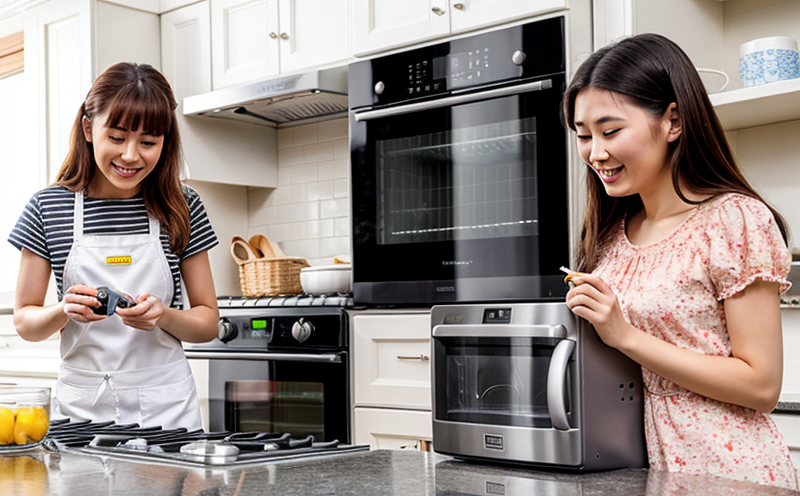ISO 3744 Acoustic Noise Testing for Household Appliances
The ISO 3744 standard provides a comprehensive framework for measuring and evaluating the acoustic noise produced by household electrical appliances. This test is crucial in ensuring that products meet stringent noise emission requirements, thereby enhancing consumer satisfaction and protecting user health.
Acoustic noise testing involves the measurement of sound pressure levels generated by household appliances during their operation. The primary objective is to ensure that these devices do not exceed permissible limits set forth by regulatory bodies such as the European Union's Directive on the restriction of certain hazardous substances (RoHS) and the Energy Star certification program.
The testing process typically begins with a thorough inspection of the appliance under test, ensuring it complies with all relevant standards. Once approved, the device is placed in an anechoic chamber designed to minimize sound reflections and interference from external sources. The chamber maintains controlled conditions, including temperature, humidity, and background noise levels.
During testing, sensors are strategically positioned around the appliance to capture accurate sound pressure level data at various locations. Advanced signal processing techniques are employed to filter out ambient noise and isolate the specific acoustic emissions of interest. Data acquisition systems then convert these raw signals into meaningful metrics, such as weighted sound levels (A-weighted, C-weighted), octave bands, and frequency-specific contributions.
The results are analyzed against established thresholds defined in ISO 3744, which account for both the type and expected usage of the appliance. Compliance with these limits indicates that the product is suitable for sale and use without causing undue discomfort or health hazards to consumers. Non-compliance may lead to market withdrawal, legal action, and reputational damage for manufacturers.
For R&D engineers, this testing offers valuable insights into potential areas of improvement. By identifying sources of excessive noise early in the design process, teams can explore innovative solutions that enhance both performance and user experience. Compliance officers benefit from having robust data to support regulatory submissions and ensure ongoing adherence to evolving standards.
Household appliance manufacturers often face challenges related to balancing sound quality with functional requirements. Achieving a harmonious balance between these factors requires careful optimization of materials, component placement, and overall design. ISO 3744 testing plays an essential role in this process by providing objective measurements that guide engineers toward optimal design choices.
By adhering to international standards like ISO 3744, companies demonstrate their commitment to producing high-quality products that meet global expectations for safety and environmental responsibility. This not only fosters trust among consumers but also enhances brand reputation and market competitiveness.
| Appliance Type | Sound Pressure Level Limits (dB) |
|---|---|
| Toaster Oven | 45 dB |
| Microwave Oven | 38 dB |
| Dishwasher | 47 dB |
| Radiator Heater | 62 dB |
| Blender | 90 dB |
Benefits
The benefits of ISO 3744 acoustic noise testing extend beyond mere compliance with regulatory requirements. For manufacturers, it offers a competitive edge by enabling them to produce quieter, more efficient appliances that resonate well with environmentally conscious consumers.
Compliance with stringent noise emission limits can significantly reduce the risk of product recalls and warranty claims. By addressing potential issues early in development, companies minimize the need for costly redesigns or retooling post-launch.
In addition to reducing liability risks, adhering to these standards contributes positively to brand perception. Consumers increasingly value sustainability and innovation, making quiet appliances a desirable feature that can set brands apart from competitors.
For quality managers and compliance officers, having reliable test data provides peace of mind knowing they are fulfilling their responsibility to protect public health and safety while maintaining regulatory integrity.
Industry Applications
This type of testing finds application across various sectors including home appliances, consumer electronics, and medical devices. The following table highlights some key applications:
| Appliance Type | Purpose of Testing |
|---|---|
| Toaster Oven | Evaluating operational noise during heating cycles. |
| Microwave Oven | Assessing emissions from door opening and closing mechanisms. |
| Dishwasher | Monitoring noise levels during wash and rinse cycles. |
| Radiator Heater | Ensuring consistent performance across different power settings. |
Customer Impact and Satisfaction
The impact of ISO 3744 testing on customer satisfaction cannot be overstated. Quieter appliances contribute to a more pleasant home environment, reducing stress levels associated with constant background noise.
In addition to enhancing user experience directly, lower noise emissions also imply better energy efficiency and reduced wear and tear on internal components. These factors collectively translate into longer product lifespans and greater value for money.
For consumers seeking eco-friendly options, the quietness of appliances aligns well with broader environmental concerns. Consequently, brands that prioritize acoustic noise testing tend to attract more environmentally aware buyers, broadening their customer base significantly.





